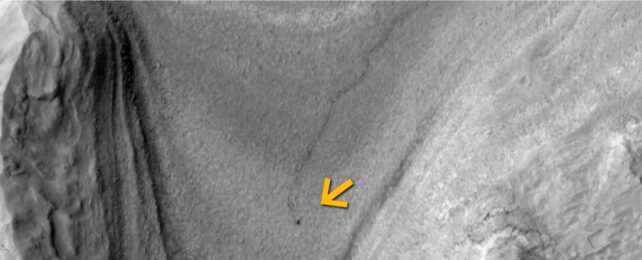Since August 2012, a lonely robot has been traversing the rocky surface of Mars on a mission of science.
In its tenure in the Gale Crater, Curiosity has revealed much about the geological and water history of the red planet, opening an invaluable window into a world so like, and unlike, our own.
But a new image from NASA's Mars Reconnaissance Orbiter really brings home the truth of Curiosity's existence: In its almost complete isolation on an alien world, far from where it began, the rover tirelessly toils to discover the secrets of Mars.
As it whooshed over the Gale Crater on February 28, the orbiter snapped a picture of the rover, which appears as a tiny black speck amid the paler Martian sands. The space agency suggests the image may be the first time a Mars orbiter has captured the rover driving across the red planet like this.
A long, meandering gray streak behind the speck – the tracks of Curiosity's wheels, spanning a stretch of around 320 meters (1,050 feet), the distance traveled over 11 drives from February 2 to the time of the photograph.

Those tracks won't last long. Mars can be tempestuous, with wild winds that will eventually blow the traces of Curiosity's journey away.
It's also not a huge distance for, say, a human wandering about in the same time frame – but Curiosity moves very slowly, with a top speed of just 160 meters (525 feet) per hour, about 40 times slower than the average person's walking speed.
There are multiple reasons for this. Slow movement helps keep power usage low; the rover is quite heavy, and is relatively low-powered, running on a 110-watt nuclear generator.
Moving slowly also allows Curiosity to safely navigate the difficult and variable Mars terrain. To date, Curiosity has covered a distance of just 34.59 kilometers.
In February, Curiosity was travelling along the Gediz Vallis channel, a feature that scientists believed was carved by large floods of water that rushed through, dumping piles of rocky debris as they went. It was in this channel that Curiosity found a cache of pure sulfur that scientists are still working to explain.
The rover has since left the channel and has explored several features, including climbing a small butte called Devil's Gate, taking chemistry readings of Cahuilla and Santa Ynez, and taking images of a formation called Hale Telescope that is layered like a cake.
It's making its way to a web-like pattern of ridges called boxwork formations at the base of Mount Sharp. Here on Earth, boxwork forms when groundwater flows through a web of fractures, depositing minerals to line the cracks. When the surrounding rock erodes over the following eons, the minerals deposited in the cracks remain, creating a delicate and fascinating relief pattern.

It's possible that the boxwork patterns on Mars formed the same way, but Curiosity is going to have to take a closer look to confirm. Scientists also want to take a look at the minerals in the formation, since they were deposited underground, where it would have been warmer and wetter than Mars is today.
These conditions are more conducive to microbial life than conditions on the surface. If trace evidence of ancient life can be found on Mars, the boxwork formation is one of the more promising places to look.
The Mars robots really are a marvel. They represent the intrepidity of the human spirit, resilience, and determination. And, of course, our boundless curiosity about the Universe in which we live.
You can follow Curiosity's adventures in the rover's science update blog.
